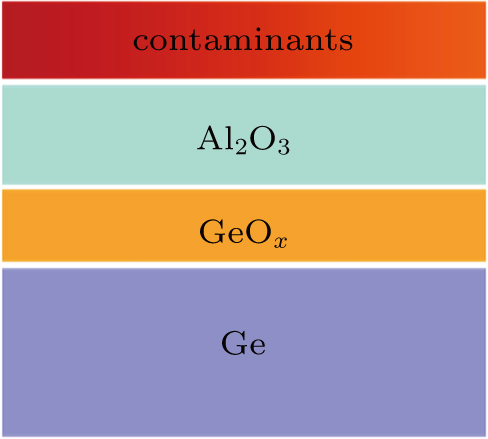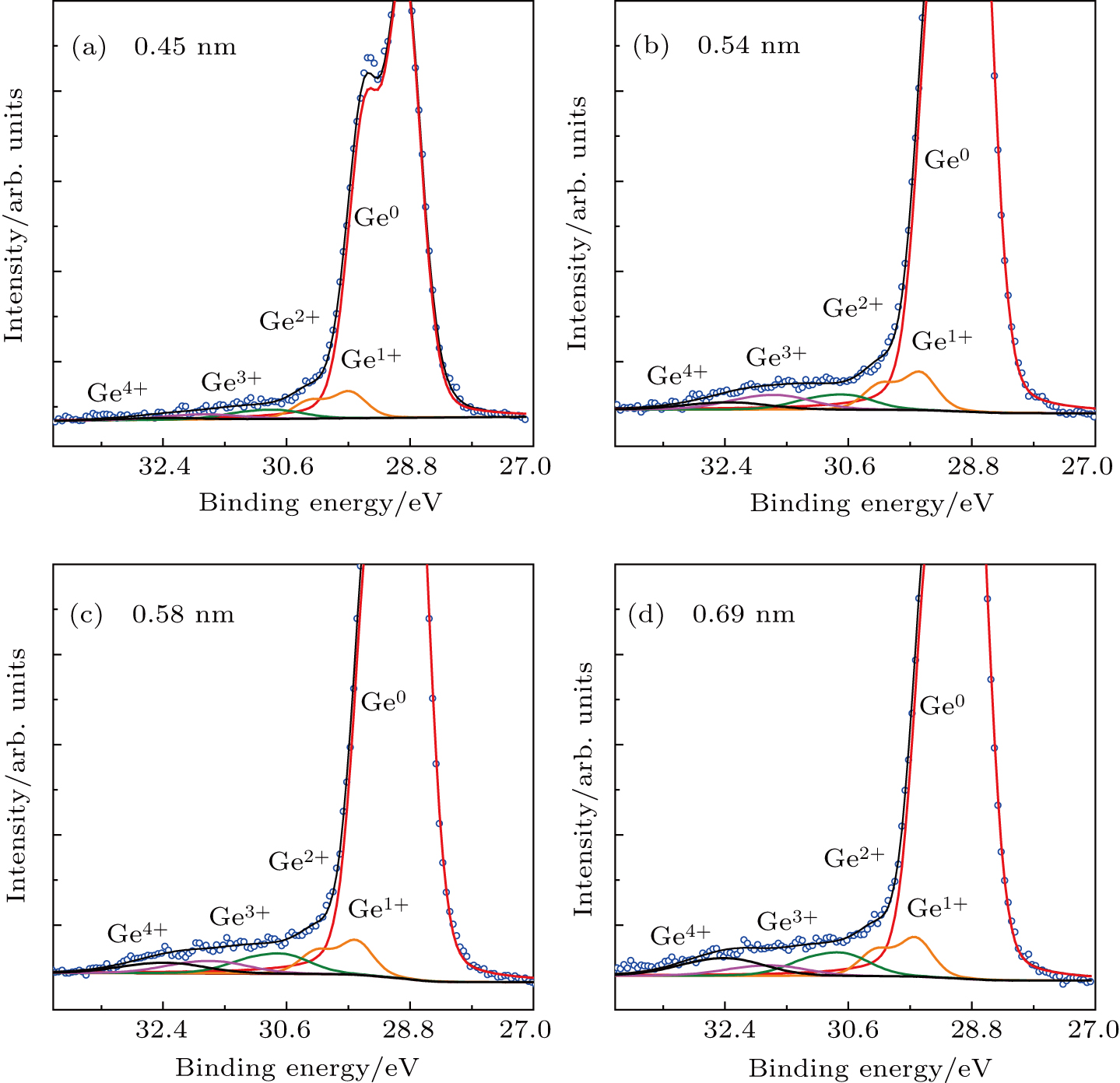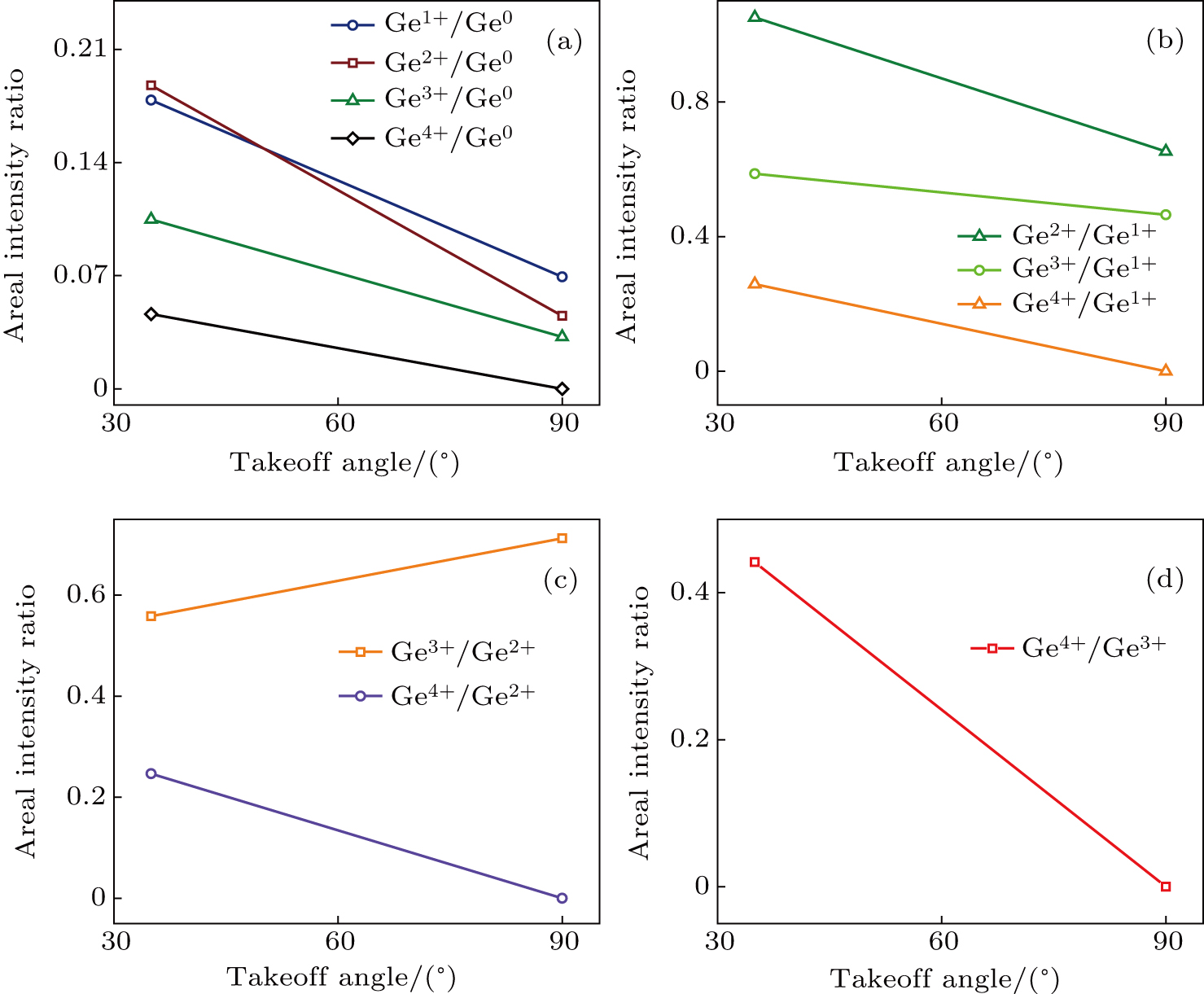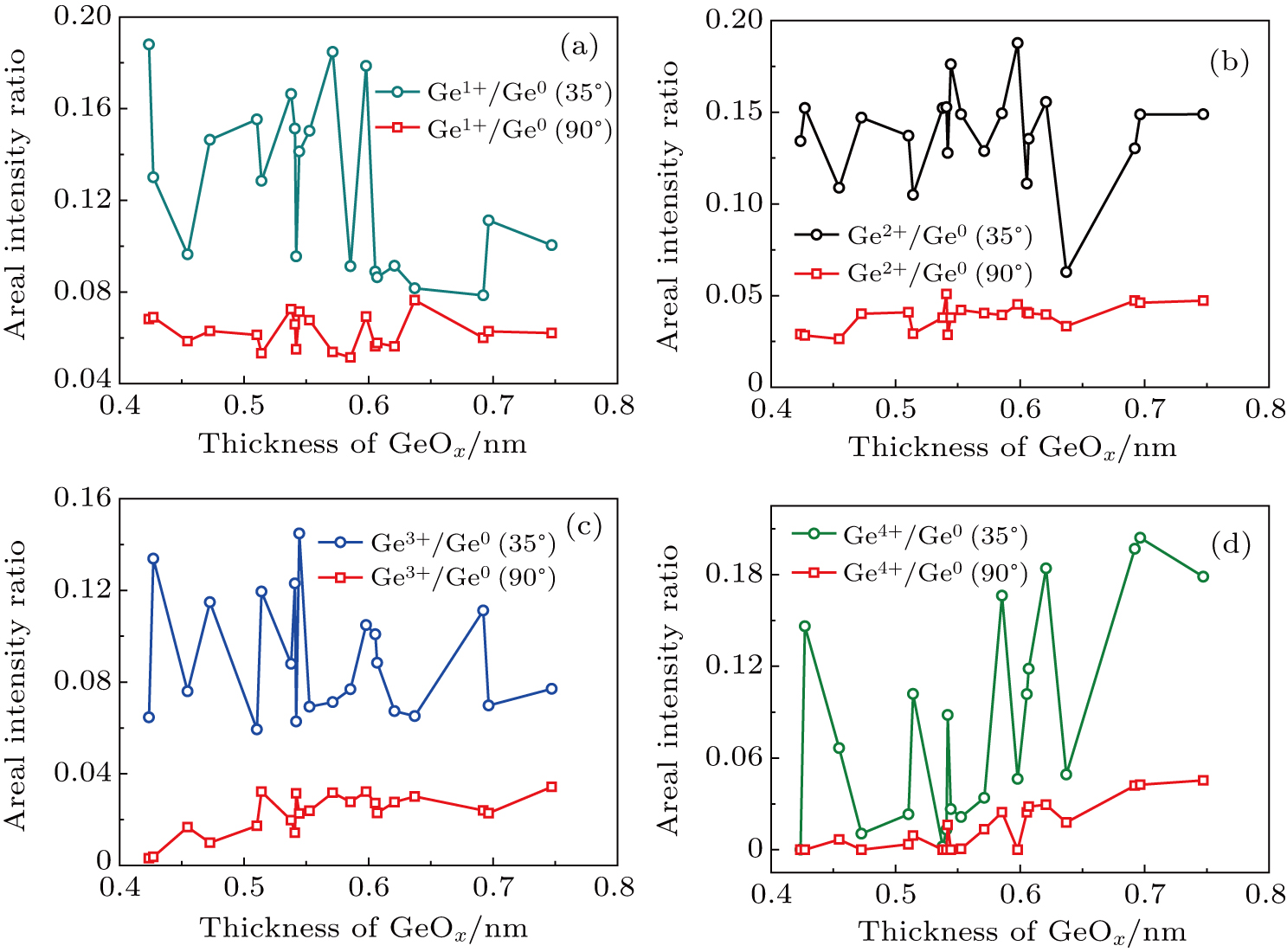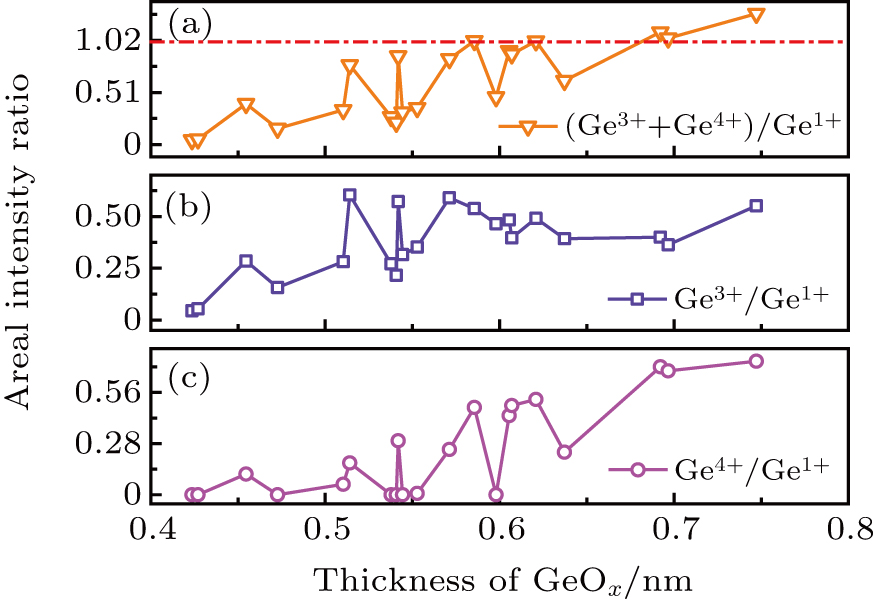† Corresponding author. E-mail:
The growth process of GeOx films formed by plasma post-oxidation (PPO) at room temperature (RT) is investigated using angle-resolved x-ray photoelectron spectroscopy (AR-XPS). The experimental results show that the distributions of the Ge4+ states, a mixture of the Ge2+ and Ge3+ states, and the Ge+1 states are localized from the GeOx surface to the GeOx/Ge interface. Moreover, the Ge+1 states are predominant when the two outermost layers of Ge atoms are oxidized. These findings are helpful for establishing in-depth knowledge of the growth mechanism of the GeOx layer and valuable for the optimization of Ge-based gate stacks for future complementary metal–oxide–semiconductor (MOS) field-effect transistor (CMOSFET) devices.
As Si transistor technology advances beyond the 10-nm node, it has been more difficult to further enhance the performance of MOSFETs on the Si platform owing to the inherent limitations of the Si material itself. The device research community is increasingly paying close attention to the replacement of Si in the transistor channel with novel and high-mobility materials.[1,2] Among several possible candidate materials, Ge is a promising material that can offer increases in the electron and hole mobilities by factors of approximately two and four, respectively, compared with those of Si and can provide compatibility with conventional Si integration technologies.[1,3,4] However, several issues still need to be resolved before Ge can be completely applied to field-effect transistors (FETs) as a proven technology to attain a high performance. One of the critical issues is to provide a high-quality interfacial layer, which can avoid causing a substantial degradation in the drive current in both the low equivalent oxide thickness (EOT) and short-channel regimes.[3]
Recently, wide ranges of materials and processes have been researched to achieve superior Ge surface passivation, including nitride,[5–11] Si,[12–15] S,[16–20] and Ge dioxide or suboxide (GeOx)[20–38] passivation layers. High-quality GeO2 has recently been reconsidered as a promising passivation layer owing to its extremely low Dit (∼ 6 × 1010 eV−1·cm−2)[39] and its potential to enable high-performance Ge n-MOSFETs.[40] GeO2 or GeOx can be grown by thermal oxidation at atmospheric pressure[21,22] and high pressure (∼ 70 atm; 1 atm = 1.01325 × 105 Pa),[23,24] respectively, as well as plasma post-oxidation (PPO)[33–38,41–46] or ozone oxidation.[29–32] Lee et al.[24] proposed a two-step oxidation process with high-pressure (70 atm) oxidation and low-temperature oxygen annealing to form an ideal GeO2/Ge stack based on thermodynamic and kinetic control. A GeO2 thickness of about 20 nm and Dit < 1011 eV−1 · cm−2 near the midgap were obtained with a peak electron mobility of 1100 cm2 · V−1·s−1. Kuzum et al.[30] used ozone oxidation to grow GeOx and achieved a mobility that is ∼ 1.5 times higher than the universal Si mobility. Zhang et al.[37] demonstrated that by using the electron cyclotron resonance oxygen PPO method, the EOT of the HfO2/Al2O3/GeOx/Ge gate stack can be scaled down to 0.7 nm–0.8 nm while maintaining Dit at a level of 1011 eV−1·cm−2. Further, the peak electron and hole mobilities were 689 cm2·V−1·s−1 and 546 cm2·V−1·s−1, respectively.
In order to further improve the interfacial properties using PPO, it is necessary to understand the distributions of various Ge oxidation states in the GeOx interfacial layer. In this paper, the areal intensity ratios of these oxidation states in a GeOx interfacial layer formed by PPO technology are investigated using angle-resolved x-ray photoelectron spectroscopy (AR-XPS). Moreover, the distributions of the Ge oxidation states are obtained by these areal intensity ratios.
In order to fabricate the GeOx/Ge interface, an HF-last process (100:1 H2O:HF for 2 min) was carried out to remove the native Ge oxide on a Ge (100) wafer. Subsequently, the wafers were immediately capped with a 3-nm-thick Al2O3 layer by atomic layer deposition (ALD) at a substrate temperature of 300 °C with Al(CH3)3 (trimethylaluminum, TMA) and H2O as precursors. Finally, the Al2O3/GeOx/Ge structure was fabricated at room temperature (RT; ∼ 20 °C) by PPO. The inductively coupled plasma (ICP) was made up of an Ar (650 sccm) and O2 (50 sccm) gas mixture, and the microwave power was 96 W. The bias voltage between the plasma source and the samples was less than 1 V. AR-XPS (Thermo Scientific ESCALAB 250xi) was performed with a monochromatic Al Kα radiation source. All high-resolution spectra were obtained with a pass energy of 15 eV. The takeoff angle was 90° when the photoelectron emission direction was normal to the sample surface.
The thickness of GeOx interface layer was controlled by regulating the time of post plasma oxidation, and the thickness of GeOx interface layer was calculated as follows. According to the theory of x-ray photoelectron spectroscopy that the intensity attenuation of photoelectron with characteristic energy obeys the exponential distribution, if each layer of atoms emits a photoelectron intensity I0 toward the surface, then the measured intensity of electrons (I′) of a given layer arriving at the surface layer will be
 |
 |
 |
On the basis of the above discussion, the equations of measured intensity of Ge and GeOx are shown as follows:
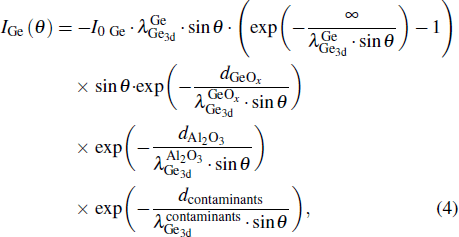 |
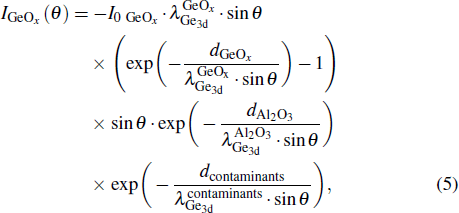 |
 |






In order to investigate the oxidation states and their distributions in the GeOx interfacial layer formed by PPO, the XPS spectra of the Ge 3d core level were recorded and analyzed. Figure
To obtain a better understanding of the oxidation process, it is necessary to clarify the depth distributions of the various oxidation states of Ge. Figure
It can be clearly observed from Fig.
For a more objective understanding of the distributions of the Ge oxidation states during the oxidation process, the areal intensity ratios of various Ge oxidation states as a function of the GeOx thickness for takeoff angles of 35° and 90° have been investigated, as shown in Figs.
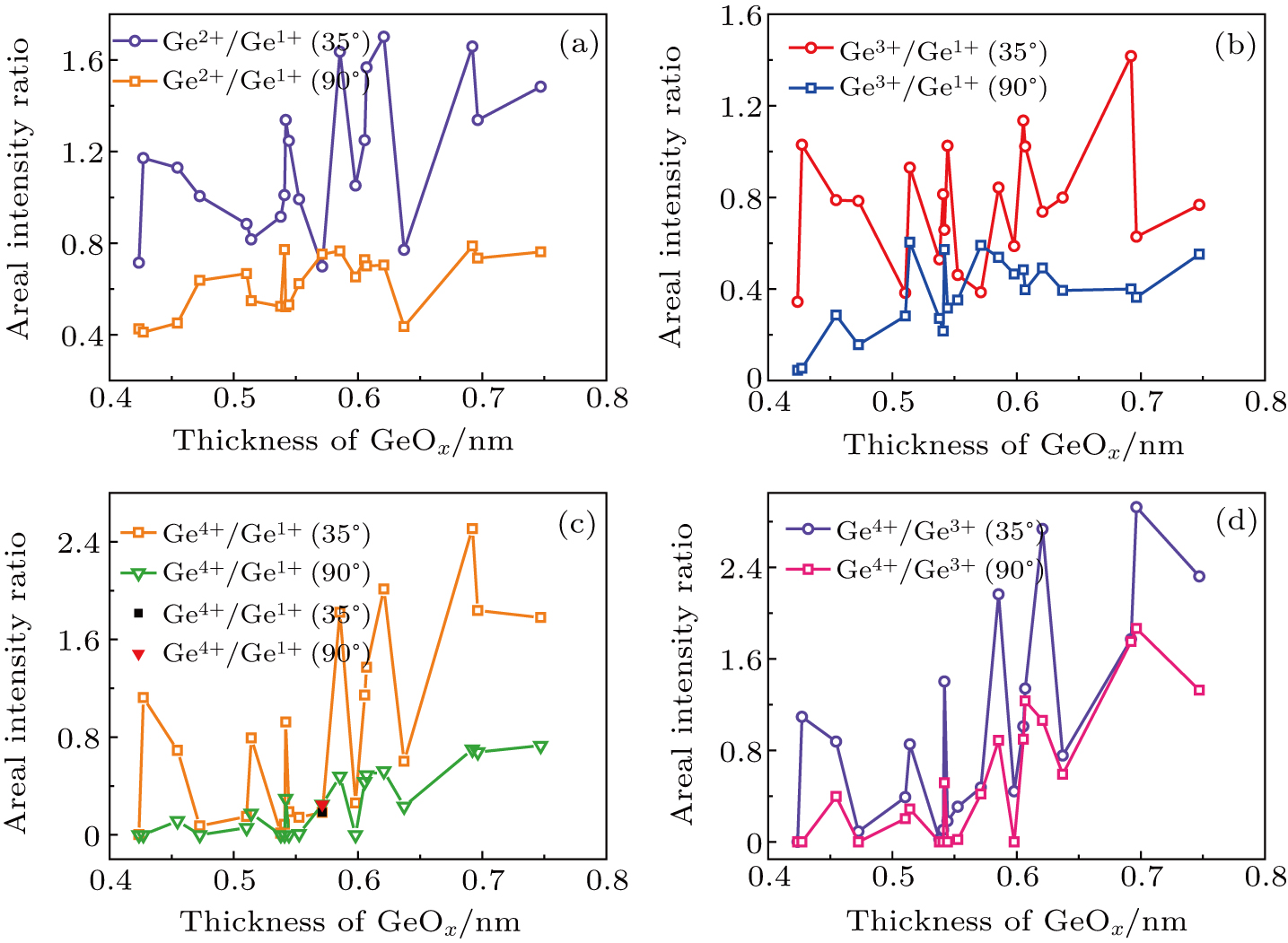 | Fig. 5. (color online) Areal intensity ratios of Gex+/Ge1+ (x = 2, 3, 4) and Ge4+/Ge3+ as a function of the GeOx thickness for takeoff angles of 35° and 90°. |
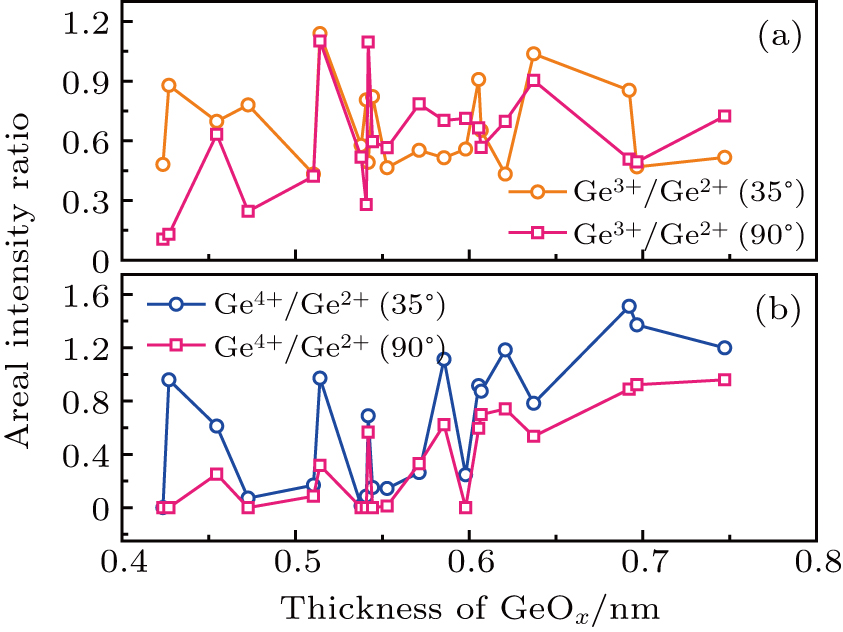 | Fig. 6. (color online) Areal intensity ratios of Ge3+/Ge2+ and Ge4+/Ge2+ as a function of the GeOx thickness for takeoff angles of 35° and 90°. |
It can be clearly observed from Fig.
Figure
In summary, the growth process of a GeOx film formed by PPO at RT is investigated on the basis of AR-XPS. In addition, the distributions of various Ge oxidation states are obtained by the areal intensity ratios of these states. It is experimentally found that the distributions of the Ge4+ states, a mixture of the Ge2+ and Ge3+ states, and the Ge1+ states are localized from the GeOx surface to the GeOx/Ge interface. Furthermore, the Ge1+ states are predominant when the two outermost layers of Ge atoms are oxidized. These experimental results are helpful for optimizing Ge-based gate stacks for future CMOSFET devices.
| [1] | |
| [2] | |
| [3] | |
| [4] | |
| [5] | |
| [6] | |
| [7] | |
| [8] | |
| [9] | |
| [10] | |
| [11] | |
| [12] | |
| [13] | |
| [14] | |
| [15] | |
| [16] | |
| [17] | |
| [18] | |
| [19] | |
| [20] | |
| [21] | |
| [22] | |
| [23] | |
| [24] | |
| [25] | |
| [26] | |
| [27] | |
| [28] | |
| [29] | |
| [30] | |
| [31] | |
| [32] | |
| [33] | |
| [34] | |
| [35] | |
| [36] | |
| [37] | |
| [38] | |
| [39] | |
| [40] | |
| [41] | |
| [42] | |
| [43] | |
| [44] | |
| [45] | |
| [46] | |
| [47] | |
| [48] | |
| [49] | |
| [50] | |
| [51] | |
| [52] | |
| [53] |


